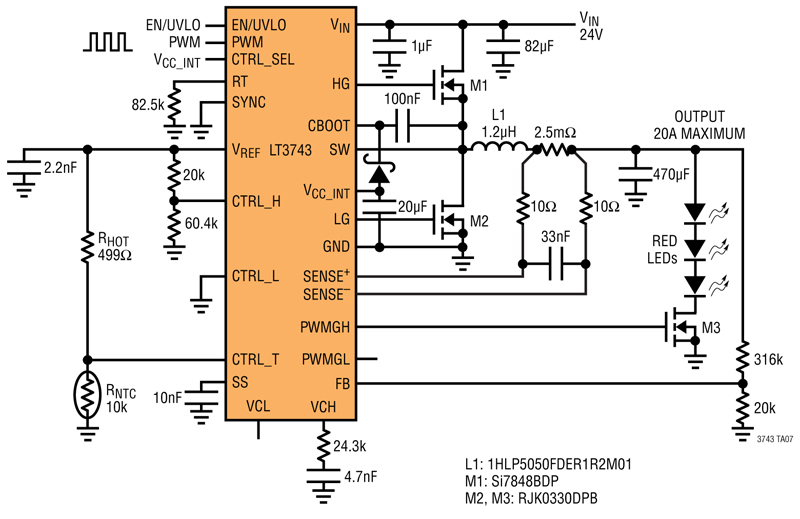Author:
Author: Tony Armstrong, Director of Product Marketing, Power Products Linear Technology
Date
05/20/2012
Incandescent light bulbs waste 90% of the energy they consume in the form of heat. The light outputs from HB (high-brightness) LEDs have already exceeded the critical milestone of 100 lm/W. In fact, some manufactures are already claiming 200 lm/W in the laboratory. Clearly then, LEDs have surpassed incandescent light bulbs—approximately 14 lm/W for a typical 60 W bulb—in terms of luminous efficacy. Even so, it is likely that within the next 12 months, LEDs with 150 lm/W output will be readily available in the marketplace. Another added benefit is LED lifetime. Depending on how one calculates it, a white LED bulb has at least a 35-khr lifetime and some even claim up to 100 khrs, while an incandescent bulb's life is around 1 khrs. To put this into perspective, if you were to use an LED bulb for 10 hours per day, every day, it should last up to 9 1/2 years - a far cry from the pitiful one-third of a year afforded by the standard incandescent bulb! The cost of HB LED lighting has also come down very quickly. The price of individual white-light diodes, which go into an LED-based bulb and make up much of the cost, have come down in price over the past few years to less than $1 today. Many LED-industry analysts predict that over the course of the year, LED bulb replacements for the incandescent light bulb will be available at prices that will be acceptable to the consumer. Some LED manufacturers already claim that they have designed light-emitting chips that could power an LED bulb producing light output comparable to a 75 W incandescent bulb so common in most homes. This type of LED chip usually requires only about 9 W to produce the same lumen output. This is less than 1/8th of the power dissipated by the equivalent incandescent bulb. However, few people realize that the key to these efficient LED light bulbs is the circuitry that drives the LEDs inside them. Amazingly, at the heart of this circuitry is the analog LED-driver IC. One key performance feature that an LED-driver IC must have today is an adequate ability to dim LEDs. LEDs operate with a constant current proportional to their brightness, but two distinct current-control methods are available to implement the dimming function. The first method is analog dimming, which uses a control pin to adjust the constant LED current. Reducing the LED current, however, can change the output color or reduce the current-control accuracy. The second method is PWM (pulse-width-modulation) dimming. PWM dimming switches the LED on and off at a frequency at or above 100Hz, which is not perceivable to the human eye. The PWM dimming duty cycle is proportional to LED brightness, while the on-time LED current remains at the same level—as set by an LED-driver IC—maintaining constant LED color during high dimming ratios. This method of PWM dimming is useful with ratios as high as 30,000:1 in certain applications. Specifically in the case of HB LEDs, LED-driver ICs must accommodate many different LED configurations with conversion topologies that meet application requirements for input voltage range, output voltage, and output current. Features of merit include:

Industrial HB LED example Other end-market applications have their own unique needs for high power HB-LED drivers where LED currents of greater than 10 A are necessary. These include DLP projectors, laser drivers, and architectural lighting. However, delivering currents greater than 10 A can bring a host of design problems, not least of which are thermal-management issues within the end product. For these applications, ICs such as the LT3743 synchronous step-down DC-DC converter deliver constant current to drive high-current LEDs. The converter can deliver up to 20A of continuous LED current from a nominal 12-V input, delivering in excess of 80 W (Figure 2). In pulsed LED applications, it can deliver up to 40 A or 160 W pk from a 12-V input. . The LT3743's unique design enables three-state current control, fast (< 2 ?s) transition times between current levels, and LED-current accuracies of �6%—all features that support color-mixing functions in RGB applications including DLP projectors. The fast transition times also support fast current pulsing in laser-driver applications. Efficiencies as high as 95% eliminate any need for external heat sinking and significantly simplify the thermal design. A frequency-adjust pin enables the user to program the frequency between 100 kHz and 1 MHz so designers can optimize efficiency while minimizing external component size. Additional features include output voltage regulation, open-LED protection, over-current protection, and a thermal de-rating circuit. In combination with a 4 mm x 5 mm QFN or thermally-enhanced TSSOP-28 package, the LT3743 offers a compact high-power LED drive. There is no doubt that there is a broad spectrum of applications for HB LEDs as many designers turn to them for their efficacy and longevity over their incandescent counterparts. Clearly, for any given application, it is the designer's responsibility to select an LED that can deliver the necessary light output. However, it is the oft-overlooked LED-driver IC that can significantly enhance the overall design. www.linear.com